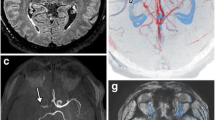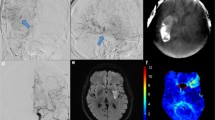Abstract
Purpose
The authors evaluated the effect of susceptibility-weighted imaging (SWI) for antiplatelet therapy on post-thrombolysis microbleeds (MB).
Materials and methods
A total of 146 patients without symptomatic intracranial haemorrhage on computed tomography after thrombolysis were allocated to two groups: group A (n = 72) received antiplatelets 24 h after recombinant tissue plasminogen activator, regardless of SWI-detected haemorrhage; group B (n = 74) received antiplatelets for patients without SWI-visualised haemorrhage.
Results
Haemorrhage was detected by SWI in 22 and 28 patients in groups A and B, respectively. The difference in mean NIHSS (National Institutes of Health Stroke Scale) score in group A between baseline and 6, 24 h, 7, 14 days was −1.6, −1.7, −3.6, −5.9, respectively; in group B, the difference in mean NIHSS score between baseline and 6, 24 h, 7, 14 days was −2.6, −3.3, −5.4, −8.7, respectively. The difference between groups in reduction of mean NIHSS score from baseline was 1.0 (p < 0.001) at 6 h, 1.6 (p < 0.001) at 24 h, 1.8 (p = 0.001) at 7 days and 2.8 (p < 0.001) at 14 days. NIHSS scores at 7, 14 days and modified Rankin scale at 90 days were significantly lower in haemorrhage patients in groups B than in A, whereas the hospital stay was shorter and the rate of favourable outcome at 90 days was higher.
Conclusion
Our results indicated that SWI was an effective approach for the guidance of antiplatelet therapy in post-thrombolysis MB.




Similar content being viewed by others
Abbreviations
- rt-PA:
-
Recombinant tissue plasminogen activator
- SWI:
-
Susceptibility-weighted imaging
- DWI:
-
Diffusion-weighted imaging
- MB:
-
Microbleeds
- SICH:
-
Symptomatic intracranial haemorrhage
- HT:
-
Haemorrhagic transformation
- PH:
-
Parenchymal haemorrhage
- NIHSS:
-
National Institutes of Health Stroke Scale
- mRS:
-
Modified Rankin scale
References
The ATLANTIS E and NINDS rt-PA Study Group Investigators, Hacke W, Donnan G, Fieschi C et al (2004) Association of outcome with early stroke treatment: pooled analysis of ATLANTIS, ECASS, and NINDS rt-PA stroke trials. Lancet 363:768–774
The NINDS t-PA Stroke Study Group (1997) Intracerebral hemorrhage after intravenous t-PA therapy for ischemic stroke. Stroke 28:2109–2118
Kimura K, Iguchi Y, Shibazaki K et al (2008) Hemorrhagic transformation of ischemic brain tissue after t-PA thrombolysis as detected by MRI may be asymptomatic, but impair neurological recovery. J Neurol Sci 272:136–142
Soo YO, Yang SR, Lam WW et al (2008) Risk vs benefit of anti-thrombotic therapy in ischaemic stroke patients with cerebral microbleeds. J Neurol 2008(255):1679–1686
Greenberg SM, Eng JA, Ning M et al (2004) Hemorrhage burden predicts recurrent intracerebral hemorrhage after lobar hemorrhage. Stroke 35:1415–1420
Lee SH, Bae HJ, Kwon SJ et al (2004) Cerebral microbleeds are regionally associated with intracerebral hemorrhage. Neurology 62:72–76
Werring DJ, Frazer DW, Coward LJ et al (2004) Cognitive dysfunction in patients with cerebral microbleeds on T2*-weighted gradient-echo MRI. Brain 127:2265–2275
UCLA Thrombolysis Investigators, Hjort N, Butcher K, Davis SM et al (2005) Magnetic resonance imaging criteria for thrombolysis in acute cerebral infarct. Stroke 36:388–397
Kang DW, Chalela JA, Dunn W et al (2005) MRI screening before standard tissue plasminogen activator therapy is feasible and safe. Stroke 36:1939–1943
Nighoghossian N, Hermier M, Adeleine P et al (2002) Old microbleeds are a potential risk factor for cerebral bleeding after ischemic stroke: a gradient-echo T2*-weighted brain MRI study. Stroke 33:735–742
Kidwell CS, Saver JL, Villablanca JP et al (2002) Magnetic resonance imaging detection of microbleeds before thrombolysis: an emerging application. Stroke 33:95–98
Kato H, Izumiyama M, Izumiyama K et al (2002) Silent cerebral microbleeds on T2*-weighted MRI: correlation with stroke subtype, stroke recurrence, and leukoaraiosis. Stroke 36:1536–1540
Senior K (2002) Microbleeds may predict cerebral bleeding after stroke. Lancet 359:769
Chalela JA, Kang DW, Warach S (2004) Multiple cerebral microbleeds: MRI marker of a diffuse hemorrhage-prone state. J Neuroimaging 14:54–57
MR STROKE Group, Fiehler J, Albers GW, Boulanger JM et al (2007) Bleeding risk analysis in stroke imaging before thrombolysis (BRASIL): pooled analysis of T2*-weighted magnetic resonance imaging data from 570 patients. Stroke 38:2738–2744
Fiehler J (2006) Cerebral microbleeds: old leaks and new haemorrhages. Int J Stroke 1:122–130
Wycliffe ND, Choe J, Holshouser B et al (2004) Reliability in detection of hemorrhage in acute stroke by a new three-dimensional gradient recalled echo susceptibility-weighted imaging technique compared to computed tomography: a retrospective study. J Magn Reson Imaging 20:372–377
Santhosh K, Kesavadas C, Thomas B et al (2009) Susceptibility weighted imaging: a new tool in magnetic resonance imaging of stroke. Clin Radiol 64:74–83
Tong KA, Ashwal S, Holshouser BA et al (2003) Hemorrhagic shearing lesions in children and adolescents with posttraumatic diffuse axonal injury: improved detection and initial results. Radiology 227:332–339
The NINDS t-PA Stroke Study Group, Lyden P, Brott T, Tilley B et al (1994) Improved reliability of the NIH stroke scale using video training. Stroke 25:2220–2226
Lövblad KO, Baird AE, Schlaug G et al (1997) Ischemic lesion volumes in acute stroke by diffusion-weighted magnetic resonance imaging correlate with clinical outcome. Ann Neurol 42:164–170
Larrue V, von Kummer RR, Muller A et al (2001) Risk factors for severe hemorrhagic transformation in ischemic stroke patients treated with recombinant tissue plasminogen activator: a secondary analysis of the European-Australasian acute stroke study (ECASS II). Stroke 32:438–441
Furlan A, Higashida R, Wechsler L et al (1999) Intra-arterial prourokinase for acute ischemic stroke. The PROACT II study: a randomized controlled trial. Prolyse in acute cerebral thromboembolism. JAMA 282:2003–2011
Van Swieten JC, Koudstaal PJ, Visser MC et al (1998) Interobserver agreement for the assessment of handicap in stroke patients. Stroke 19:604–607
Kidwell CS, Chalela JA, Saver JL et al (2004) Comparison of MRI and CT for detection of acute intracerebral hemorrhage. JAMA 292:1823–1830
Roob G, Schmidt R, Kapeller P et al (1999) MRI evidence of past cerebral microbleeds in a healthy elderly population. Neurology 52:991–994
Kwa VI, Franke CL, Verbeeten B et al (1998) Silent intracerebral microhemorrhages in patients with ischemic stroke. Amsterdam Vascular Medicine Group. Ann Neurol 44:372–377
Conflict of interest
Lei Yan1, Yong-Dong Li1, Yue-Hua Li1, Ming-Hua Li1, Jun-Gong Zhao1, Shi-Wen Chen2, declare that they have no conflicts of interest.
Financial Disclosure
This study has been supported by the National Natural Scientific Fund of China (Contract number: 81000609).
Author information
Authors and Affiliations
Corresponding author
Rights and permissions
About this article
Cite this article
Yan, L., Li, YD., Li, YH. et al. Outcomes of antiplatelet therapy for haemorrhage patients after thrombolysis: a prospective study based on susceptibility-weighted imaging. Radiol med 119, 175–182 (2014). https://doi.org/10.1007/s11547-013-0328-1
Received:
Accepted:
Published:
Issue Date:
DOI: https://doi.org/10.1007/s11547-013-0328-1




